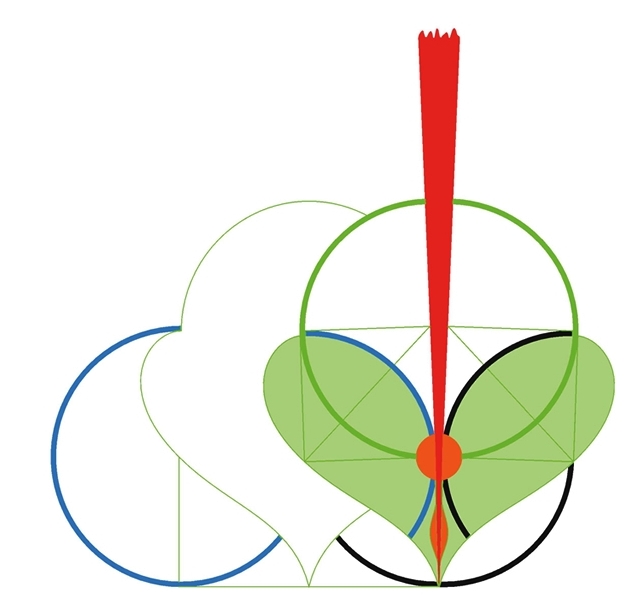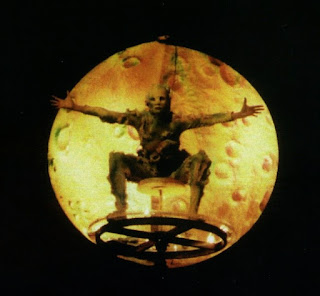Friday from Light (1991-1994)
for soprano, baritone and bass vocal soloists, flute, basset horn, children’s orchestra, children’s choir, 12 choir singers, synthesizer, tape (staged with 12 pairs of dancer-mimes).
FREITAG is the Day of Temptation where LUCIFER attempts to tempt EVE into joining his revolution against Heaven. At first EVE resists, but the children of LUCIFER and the children of EVE meet and play together. However a Children's War soon shatters the union.
 |
| Johannes Cohen, 1995 (©www.karlheinzstockhausen.org) |
FREITAG aus LICHT (Friday From Light) is the 5th opera in Karlheinz Stockhausen's "7 day" LICHT (Light) opera cycle, following DIENSTAG aus LICHT. The composition of the opening and closing electronic music sequences (FREITAGs-GRUSS and FREITAGs-ABSCHIED) began in 1991 and was completed in 1994. The vocal and electronic music "Sound Scene" interludes distributed throughout the main opera (PAARE vom FREITAG) were created in 1992. The composition of the vocal, choral and instrumental "Real Scenes" took place throughout 1991 to 1994. Stockhausen's progress on FREITAG aus LICHT was sometimes temporarily halted due to work necessary for the staged premiere production of DIENSTAG aus LICHT, as well as the creation of the HELIKOPTER-STREICHQUARTETT (Helicopter String Quartet), later to be included in the next LICHT opera, Wednesday From Light.
Synopsis
FREITAG is the Day of Temptation, where the LICHT antagonist Lucifer (here represented by the character "Ludon") attempts to lure the female protagonist Eve into bonding with his son, "Caino", and joining his revolution against Heaven (and the hero Michael). Distributed between the staged narrative scenes are somewhat disturbing (but sensuous) "Sound Scenes", featuring pairs of frolicking dancers dressed as bizarre animate and inanimate objects. These Couples are aurally heard as distorted blends of human, animal and mechanical sounds. Eventually hybrid "children" are borne from these Couples. Throughout, the underlying electronic music conveys a sense of menace and foreboding.
Representing a more "human" force, the soprano Eve is accompanied instrumentally by her somewhat more light-hearted companions "Elu" and "Lufa" (a pair of earthy basset horn and flute soloists). The drama between Eve and Ludon comes to a head when a "children's war" erupts between their respective children's choir groups - dramatically staged with toy laser weapons and a giant, flame-breathing rhinoceros. At the end, the Hybrid children of the Sound Scene Couples peacefully float away in a Choir Spiral.
FREITAGs-GRUSS and FREITAGs-ABSCHIED (WELTRAUM)
This is the electronic music used for the audience arrival and departure "Greeting" and "Farewell". This same tape is employed during the main opera scenes as a supporting electronic sound layer.
Friday Greeting and Friday Farewell Electronic Music: Further Analysis and Listening Guide
FREITAG-VERSUCHUNG (Friday Temptation)
The dramatic arc of Friday From Light is related through ten vocal scenes ("Real Scenes") grouped into two acts. These plot scenes are separated by the more abstract "Sound Scenes" in which selected pairs of dancers costumed as related animal and mechanical figures) pantomime exotic sexual activities in sync with the electronic music ("Couples of Friday") projected from 8 speakers. Examples of these paired couples (12 in total) include a man and woman, a cat and a dog, a photocopy machine and a typewriter, a race car and its driver, etc...
- ANTRAG (Proposal), featuring soprano, bass, flute, basset horn (quartet): Eve (followed by "Elu" (her basset horn companion) and "Lufa" (her flute companion)), emerges descending a rocky path. Lucifer (in the form of "Ludon") greets her, and proposes that she "yields" to his son, "Caino". Eve is doubtful, but they arrange a further meeting to introduce their respective children. In general, this is a fairly subdued scene with contrapuntal dialogue figures in broad (but foreboding) gestures.
- KINDER-ORCHESTER (Children's Orchestra)/KINDER-CHOR (Children's Choir)/KINDER-TUTTI (Children's Tutti), featuring soprano, bass, children's orchestra, children's choir, flute, basset horn, synthesizer: Eve (with Elu & Lufa) arrives with her children (dressed in white), who arrive playing Western concert instruments. Ludon then arrives with his children's choir (wearing black and red garments), who shake and rattle African rhythm instruments. A "Synthibird" (synthesizer accompanist) also appears. Eve and her young entourage (including Elu and Lufa) play for Ludon's children, accompanied by Synthibird. This opening musical sequence is in a brisker tempo and is based on ensemble melodic figures, supported by restless synthesizer accents. Afterwards, Ludon's children are impressed, and applaud with their percussion instruments. Ludon's children's choir then sings, also accompanied by Synthibird. During this sequence, each of Ludon's 24 children offer brief, playful solos (Ludon also has a "teaching moment" solo sequence here). Afterwards, Eve and Ludon's combined ensembles sing/play angular melodic figures in unison. At the end, Eve, Ludon and their children depart in laughter and joy.
- ZUSTIMMUNG (Consent), featuring soprano, bass, flute, basset horn (quartet): Eve (with Elu & Lufa) appears before Ludon, who presents Eve with a black talisman. Eve consents to a union with Ludon's son Caino (in order to "advance the evolution of Mankind") and hands the talisman back to Ludon. Musically, this scene is an elaboration of the 1st scene's quartet.
INTERMISSION
 |
| The color for FRIDAY is ORANGE. |
- Appearance of Hybrid Couples: In the second act, the Real Scenes continue to be separated by the paired Sound Scene lovers. However, after the Real Scene FALL, adjacent couples begin to "swap partners" during the Sound Scenes. After each of these "inter-animate" couplings, a "hybrid" ani-mechanical couple appears between the neighboring couples. These new Hybrid Couples (ultimately 6 pairs in all) take on the combined forms of their "parents" (for example, a dog-woman and a man-cat, a car-typewriter and a car driver in a photocopy machine, etc...). As they are borne, they begin singing quiet held harmonies.
- FALL, featuring soprano, baritone, flute, basset horn (quartet): Eve (with Elu & Lufa) arrives in a boat (broad flute and basset horn lines with synth drones). They greet Ludon's son Caino (a baritone) who sits on the shore of a moonlit lake. Eve and Caino "entwine themselves" and sing a sensuous duet. Afterwards, Eve departs on her boat, as a red comet shoots across the sky (accompanied by the cry of betrayed Michael).
- KINDERKRIEG (Children's War), featuring children's choir, synthesizer (optional basset horn): In this scene the children of Eve (armed with modern armaments) battle the children of Ludon (armed with primitive wood and stone weapons). The battle sequence ends as a giant winged rhinoceros sends the white children into a retreat. This conflict is musically expressed through contrapuntal "dueling" children's choir melodies and synthesizer sound effects.
- REUE (Repentance), featuring soprano, flute, basset horn (trio): Eve (with Elu & Lufa) returns to the lake shore where she had had her tryst with Caino. She sings an aria of repentance, supported by her basset horn and flute companions. At the same time, Eve also makes INORI gestures (a form of "sign language") as a parallel layer of regretful beseechment.
- ELUFA, featuring flute & basset horn: Elu and Lufa musically ruminate upon the drama that has transpired. The 12 "parent" Couples pronounce their repentance and then disappear (although their Hybrid Couple progeny remain, and begin to congregate).
- CHOR-SPIRALE (Choir Spiral), featuring choir: The 6 pairs of Hybrid Couples unite in a giant candle flame while singing, eventually rising up in a slow spiral movement and vanishing into the Beyond.
 |
| Johannes Cohen, 1995 (©www.karlheinzstockhausen.org) |
Sound Scenes Further Analysis and Listening Guide
Day of Temptation
Friday from Light continues the "dark streak" begun in Tuesday from Light. For example, where the Tuesday episode portrayed the war between Michael and Lucifer in "adult" battlefield terms, Friday's conflict is climaxed by a fantastical "children's war" between Eve and Lucifer's children. In many ways Friday is a direct sequel to Tuesday and together they make for a thought-provoking pair.
Musically, Stockhausen's concept of placing vocal and instrumental forces next to and in tandem with much more abstract electronic and concrete music works really well, and by using WELTRAUM as an electronic background layer (faded in and out), a unified "mood" is established, almost like how a color scheme is applied to a film. The vocally-driven "cybernetic" music of the Sound Scenes also provides a fascinating contrast to the staged performances. Due partly to the vocoder-related abstract sound elements and textures (as well as the strangely-costumed dancers), they provide an exotic contrast to the more "natural" harmony and costuming found in the Real Scenes.
The vocal, choral and instrumental combinations making up the musical fabric of the Real Scenes are based on somewhat simplified versions of the LICHT "super-formula" (which were introduced and explored in the first three LICHT operas). These simplified thematic forms are based on sensuous "gliding" figures (oftentimes in counterpoint), resulting in possibly some of the most classically-romantic works of Stockhausen's entire oeuvre.
 |
| (from Children's War) (© www.karlheinzstockhausen.org) |
| FRIDAY
GREETING (Outer Space Pt 1) |
Tape (modified vocal and concrete sounds) |
| FRIDAY TEMPTATION: | Soprano, Baritone and Bass vocal soloists, flute, bassett horn, choir, children’s choir and "orchestra", synthesizer, tape (modified vocal and concrete sounds) |
| PROPOSAL | (feat. Soprano and Bass vocal soloists, flute, bassett horn) |
| CHILDREN'S ORCHESTRA | (feat. Soprano and Bass vocal soloists, 2-part children's choir and soloists) |
| CONSENT | (feat. Soprano and Bass vocal soloists, flute, bassett horn) |
| FALL | (feat. Soprano and Baritone vocal soloists, flute, bassett horn) |
| CHILDREN'S WAR | (feat. 2-part children's choir & synthesizer (PIANO PIECE XVII)) |
| REPENTANCE | (feat. Soprano vocal soloist, flute, bassett horn) |
| ELUFA | (feat. bassett horn, flute) |
| CHOIR-SPIRAL | (feat. 2-part mixed choir) |
COUPLES OF FRIDAY |
Soprano and Bass processed with concrete music |
| FRIDAY FAREWELL (Outer Space Pt 2) |
Tape (modified vocal and concrete sounds) |
Released on Stockhausen Edition CD 50
- FREITAGS GRUSS (Friday Greeting): Ambient electronic music for audience arrival. Rec. 1992/94.
- FREITAG-VERSUCHUNG (Friday Temptation): Two Acts with an intermission, featuring the above listed personnel performing opera "Real Scenes" separated by the taped "Sound Scenes". Rec. 1996.
- FREITAGS ABSCHIED (Friday Farewell): Ambient electronic music for audience departure. Rec. 1992/94.
 |
| Stockhausen's FREITAG aus LICHT and its sub-works (click to enlarge). See also LICHT Works. |
| Additional Arrangements from FREITAG aus LICHT | Stockhausen Edition CD |
| FREIA for basset horn (1991) | 32 Suzanne Stephens (Works 1989-94) |
| FREIA for flute (1991) | 57 LICHT Chamber Works (Pasveer/Abellán) |
| WELTRAUM/ELECTRONIC MUSIC of FREITAG aus LICHT (assembled from FREITAGs GRUSS/ABSCHIED/PAARE) | 49 FREITAG aus LICHT: ELECTRONIC MUSIC |
| PAARE vom FREITAG | 48 PAARE vom FREITAG |
| TWO COUPLES (1992/99) | 64 Electronic and Concrete Music |
| KLAVIERSTÜCK XVI (derived from Sound Scene 12 of FREITAG aus LICHT) for tape, piano, synth (1995) | 57 LICHT Chamber Works (Pasveer/Abellán) |
| Electronic and Concrete Music for KOMET (1994/99) | 64 Electronic and Concrete Music |
| KOMET, or Klavierstück XVII for synth, tape (1995) | 57 LICHT Chamber Works (Pasveer/Abellán) |
| KOMET for a percussionist (Andreas Boettger), electronic and concrete music (1994/99) | 79 Percussion & Electronics |
| KOMET for a percussionist (Stuart Gerber), electronic and concrete music (1994/99) | 82 Brass, Reeds, Percussion & Electronics |
| VIBRA-ELUFA for vibraphone (2003) | 79 Percussion & Electronics |


